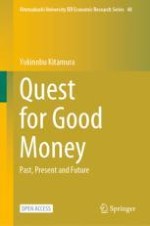Open Access 2022 | Open Access | Book

Quest for Good Money
Past, Present and Future
Author: Yukinobu Kitamura
Publisher: Springer Nature Singapore
Book Series : Hitotsubashi University IER Economic Research Series
Open Access 2022 | Open Access | Book

Author: Yukinobu Kitamura
Publisher: Springer Nature Singapore
Book Series : Hitotsubashi University IER Economic Research Series
This open access book examines the history and role of money. Money is often defined in terms of three interrelated functions: as a medium of exchange, store of value and unit of account. Researchers frequently discuss the first two functions, but tend to ignore unit of account. This book focuses on how a unit of account or denomination can be defined and can be derived from the monetary system. In the case of paper money and coins, we know how to determine the denomination of money based on the problem of the least number of weights defined by Bâchet and proved by Hardy and Wright (1960). However, in the case of digital or cryptocurrency, denomination may not matter because digital or cryptocurrency uses a wallet that is essentially denomination free: a wallet can contain any amount of currency without upper and lower limits. When people talk about the stablecoin, i.e. the stable price of digital and cryptocurrency with the major legal tender, they take a unit of account or denomination of digital or cryptocurrency as given. This arrangement destroys the nature of denomination free or decentralized autonomy as it were.
Exploring how we can consolidate with these two views of denomination, this book will appeal to anyone interested in creating new digital or cryptocurrencies. It also serves as a textbook on central bank digital currency.